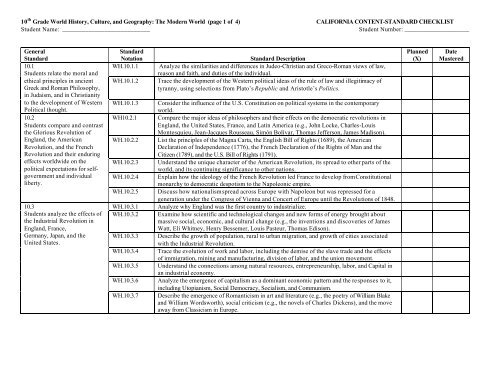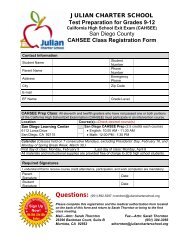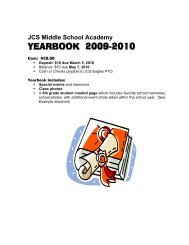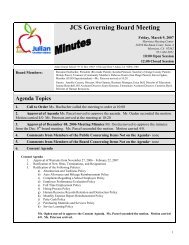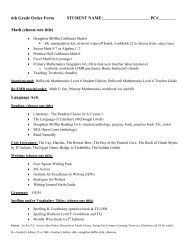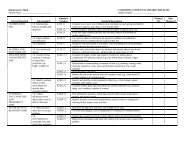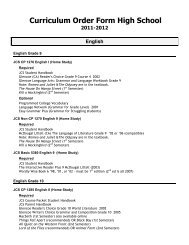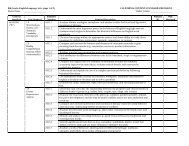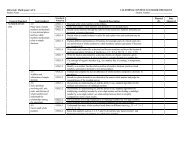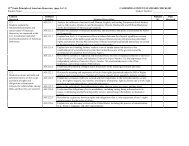10th Grade World History, Culture, and Geography - Julian Charter ...
10th Grade World History, Culture, and Geography - Julian Charter ...
10th Grade World History, Culture, and Geography - Julian Charter ...
You also want an ePaper? Increase the reach of your titles
YUMPU automatically turns print PDFs into web optimized ePapers that Google loves.
10 th <strong>Grade</strong> <strong>World</strong> <strong>History</strong>, <strong>Culture</strong>, <strong>and</strong> <strong>Geography</strong>: The Modern <strong>World</strong> (page 1 of 4) CALIFORNIA CONTENT-STANDARD CHECKLIST<br />
Student Name: ___________________________<br />
Student Number: ____________________<br />
General<br />
St<strong>and</strong>ard<br />
10.1<br />
Students relate the moral <strong>and</strong><br />
ethical principles in ancient<br />
Greek <strong>and</strong> Roman Philosophy,<br />
in Judaism, <strong>and</strong> in Christianity<br />
to the development of Western<br />
Political thought.<br />
10.2<br />
Students compare <strong>and</strong> contrast<br />
the Glorious Revolution of<br />
Engl<strong>and</strong>, the American<br />
Revolution, <strong>and</strong> the French<br />
Revolution <strong>and</strong> their enduring<br />
effects worldwide on the<br />
political expectations for selfgovernment<br />
<strong>and</strong> individual<br />
liberty.<br />
10.3<br />
Students analyze the effects of<br />
the Industrial Revolution in<br />
Engl<strong>and</strong>, France,<br />
Germany, Japan, <strong>and</strong> the<br />
United States.<br />
St<strong>and</strong>ard<br />
Notation<br />
WH.10.1.1<br />
WH.10.1.2<br />
WH.10.1.3<br />
WH10.2.1<br />
WH.10.2.2<br />
WH.10.2.3<br />
WH.10.2.4<br />
WH.10.2.5<br />
WH.10.3.1<br />
WH.10.3.2<br />
WH.10.3.3<br />
WH.10.3.4<br />
WH.10.3.5<br />
WH.10.3.6<br />
WH.10.3.7<br />
St<strong>and</strong>ard Description<br />
Analyze the similarities <strong>and</strong> differences in Judeo-Christian <strong>and</strong> Greco-Roman views of law,<br />
reason <strong>and</strong> faith, <strong>and</strong> duties of the individual.<br />
Trace the development of the Western political ideas of the rule of law <strong>and</strong> illegitimacy of<br />
tyranny, using selections from Plato’s Republic <strong>and</strong> Aristotle’s Politics.<br />
Consider the influence of the U.S. Constitution on political systems in the contemporary<br />
world.<br />
Compare the major ideas of philosophers <strong>and</strong> their effects on the democratic revolutions in<br />
Engl<strong>and</strong>, the United States, France, <strong>and</strong> Latin America (e.g., John Locke, Charles-Louis<br />
Montesquieu, Jean-Jacques Rousseau, Simón Bolívar, Thomas Jefferson, James Madison).<br />
List the principles of the Magna Carta, the English Bill of Rights (1689), the American<br />
Declaration of Independence (1776), the French Declaration of the Rights of Man <strong>and</strong> the<br />
Citizen (1789), <strong>and</strong> the U.S. Bill of Rights (1791).<br />
Underst<strong>and</strong> the unique character of the American Revolution, its spread to other parts of the<br />
world, <strong>and</strong> its continuing significance to other nations.<br />
Explain how the ideology of the French Revolution led France to develop from Constitutional<br />
monarchy to democratic despotism to the Napoleonic empire.<br />
Discuss how nationalism spread across Europe with Napoleon but was repressed for a<br />
generation under the Congress of Vienna <strong>and</strong> Concert of Europe until the Revolutions of 1848.<br />
Analyze why Engl<strong>and</strong> was the first country to industrialize.<br />
Examine how scientific <strong>and</strong> technological changes <strong>and</strong> new forms of energy brought about<br />
massive social, economic, <strong>and</strong> cultural change (e.g., the inventions <strong>and</strong> discoveries of James<br />
Watt, Eli Whitney, Henry Bessemer, Louis Pasteur, Thomas Edison).<br />
Describe the growth of population, rural to urban migration, <strong>and</strong> growth of cities associated<br />
with the Industrial Revolution.<br />
Trace the evolution of work <strong>and</strong> labor, including the demise of the slave trade <strong>and</strong> the effects<br />
of immigration, mining <strong>and</strong> manufacturing, division of labor, <strong>and</strong> the union movement.<br />
Underst<strong>and</strong> the connections among natural resources, entrepreneurship, labor, <strong>and</strong> Capital in<br />
an industrial economy.<br />
Analyze the emergence of capitalism as a dominant economic pattern <strong>and</strong> the responses to it,<br />
including Utopianism, Social Democracy, Socialism, <strong>and</strong> Communism.<br />
Describe the emergence of Romanticism in art <strong>and</strong> literature (e.g., the poetry of William Blake<br />
<strong>and</strong> William Wordsworth), social criticism (e.g., the novels of Charles Dickens), <strong>and</strong> the move<br />
away from Classicism in Europe.<br />
Planned<br />
(X)<br />
Date<br />
Mastered
10 th <strong>Grade</strong> <strong>World</strong> <strong>History</strong>, <strong>Culture</strong>, <strong>and</strong> <strong>Geography</strong>: The Modern <strong>World</strong> (page 2 of 4) CALIFORNIA CONTENT-STANDARD CHECKLIST<br />
Student Name: ___________________________<br />
Student Number: ____________________<br />
General<br />
St<strong>and</strong>ard<br />
St<strong>and</strong>ard<br />
Notation<br />
St<strong>and</strong>ard Description<br />
10.4<br />
WH.10.4.1 Describe the rise of industrial economies <strong>and</strong> their link to imperialism <strong>and</strong> colonialism (e.g.,<br />
Students analyze patterns of<br />
the role played by national security <strong>and</strong> strategic advantage; moral issues raised by the search<br />
global change in the era of New<br />
for national hegemony, Social Darwinism, <strong>and</strong> the missionary impulse; material issues such as<br />
Imperialism in at<br />
l<strong>and</strong>, resources, <strong>and</strong> technology).<br />
least two of the following WH.10.4.2 Discuss the locations of the colonial rule of such nations as Engl<strong>and</strong>, France, Germany, Italy,<br />
regions or countries: Africa,<br />
Japan, the Netherl<strong>and</strong>s, Russia, Spain, Portugal, <strong>and</strong> the United States.<br />
Southeast Asia, China, WH.10.4.3 Explain imperialism from the perspective of the colonizers <strong>and</strong> the colonized <strong>and</strong> the varied<br />
India, Latin America, <strong>and</strong> the<br />
immediate <strong>and</strong> long-term responses by the people under colonial rule.<br />
Philippines. WH.10.4.4 Describe the independence struggles of the colonized regions of the world, including the roles<br />
of leaders, such as Sun Yat-sen in China, <strong>and</strong> the roles of ideology <strong>and</strong> religion.<br />
10.5<br />
WH.10.5.1 Analyze the arguments for entering into war presented by leaders from all sides of the Great<br />
Students analyze the causes <strong>and</strong><br />
War <strong>and</strong> the role of political <strong>and</strong> economic rivalries, ethnic <strong>and</strong> ideological conflicts, domestic<br />
course of the First <strong>World</strong> War.<br />
discontent <strong>and</strong> disorder, <strong>and</strong> propag<strong>and</strong>a <strong>and</strong> nationalism in mobilizing the civilian population<br />
in support of “total war.”<br />
WH.10.5.2 Examine the principal theaters of battle, major turning points, & the importance of geographic<br />
factors in military decisions <strong>and</strong> outcomes (e.g., topography, waterways, distance, climate).<br />
WH.10.5.3 . Explain how the Russian Revolution <strong>and</strong> the entry of the United States affected the course<br />
<strong>and</strong> outcome of the war.<br />
WH.10.5.4 Underst<strong>and</strong> the nature of the war <strong>and</strong> its human costs (military <strong>and</strong> civilian) on all sides of the<br />
conflict, including how colonial peoples contributed to the war effort.<br />
WH.10.5.5 Discuss human rights violations <strong>and</strong> genocide, including the Ottoman government’s actions<br />
10.6<br />
Students analyze the effects of<br />
the First <strong>World</strong> War.<br />
10.7<br />
Students analyze the rise of<br />
totalitarian governments after<br />
<strong>World</strong> War I.<br />
WH.10.6.1<br />
WH.10.6.2<br />
WH.10.6.3<br />
WH.10.6.4<br />
WH.10.7.1<br />
WH.10.7.2<br />
WH.10.7.3<br />
against Armenian citizens.<br />
Analyze the aims <strong>and</strong> negotiating roles of world leaders, the terms <strong>and</strong> influence of the Treaty<br />
of Versailles <strong>and</strong> Woodrow Wilson’s Fourteen Points, <strong>and</strong> the causes <strong>and</strong> effects of the United<br />
States’s rejection of the League of Nations on world politics.<br />
Describe the effects of the war <strong>and</strong> resulting peace treaties on population movement, the<br />
international economy, & shifts in geographic & political borders of Europe & Middle East.<br />
Underst<strong>and</strong> the widespread disillusionment with prewar institutions, authorities, <strong>and</strong> values<br />
that resulted in a void that was later filled by totalitarians.<br />
Discuss the influence of <strong>World</strong> War I on literature, art, <strong>and</strong> intellectual life in the West (e.g.,<br />
Pablo Picasso, the “lost generation” of Gertrude Stein, Ernest Hemingway).<br />
Underst<strong>and</strong> the causes <strong>and</strong> consequences of the Russian Revolution, including Lenin’s use of<br />
totalitarian means to seize <strong>and</strong> maintain control (e.g., the Gulag).<br />
Trace Stalin’s rise to power in the Soviet Union <strong>and</strong> the connection between economic<br />
policies, political policies, the absence of a free press, <strong>and</strong> systematic violations of human<br />
rights (e.g., the Terror Famine in Ukraine).<br />
Analyze the rise, aggression, <strong>and</strong> human costs of totalitarian regimes (Fascist <strong>and</strong> Communist)<br />
in Germany, Italy, <strong>and</strong> the Soviet Union, noting especially their common <strong>and</strong> dissimilar traits.<br />
Planned<br />
(X)<br />
Date<br />
Mastered
10 th <strong>Grade</strong> <strong>World</strong> <strong>History</strong>, <strong>Culture</strong>, <strong>and</strong> <strong>Geography</strong>: The Modern <strong>World</strong> (page 3 of 4)<br />
Student Name: ___________________________<br />
CALIFORNIA CONTENT-STANDARD CHECKLIST<br />
Student Number: ____________________<br />
General<br />
St<strong>and</strong>ard<br />
10.8 Students analyze the<br />
causes <strong>and</strong> consequences of<br />
<strong>World</strong> War II.<br />
10.9<br />
Students analyze the<br />
international developments in<br />
the post–<strong>World</strong> War II<br />
world.<br />
St<strong>and</strong>ard<br />
Notation<br />
St<strong>and</strong>ard Description<br />
WH.10.8.1 Compare the German, Italian, <strong>and</strong> Japanese drives for empire in the 1930s, including the 1937<br />
Rape of Nanking, other atrocities in China, <strong>and</strong> the Stalin-Hitler Pact of 1939.<br />
WH.10.8.2 Underst<strong>and</strong> the role of appeasement, nonintervention (isolationism), <strong>and</strong> the domestic<br />
distractions in Europe <strong>and</strong> the United States prior to the outbreak of <strong>World</strong> War II.<br />
WH.10.8.3 Identify <strong>and</strong> locate the Allied <strong>and</strong> Axis powers on a map <strong>and</strong> discuss the major turning points<br />
of the war, the principal theaters of conflict, key strategic decisions, <strong>and</strong> the resulting war<br />
conferences <strong>and</strong> political resolutions, with emphasis on the importance of geographic factors.<br />
WH.10.8.4 Describe the political, diplomatic, <strong>and</strong> military leaders during the war (e.g., Winston Churchill,<br />
Franklin Delano Roosevelt, Emperor Hirohito, Adolf Hitler, Benito Mussolini, Joseph Stalin,<br />
Douglas MacArthur, Dwight Eisenhower).<br />
WH.10.8.5 Analyze the Nazi policy of pursuing racial purity, especially against the European Jews; its<br />
transformation into the Final Solution; <strong>and</strong> the Holocaust that resulted in the murder of six<br />
million Jewish civilians.<br />
WH.10.8.6 Discuss the human costs of the war, with particular attention to the civilian <strong>and</strong> military losses<br />
in Russia, Germany, Britain, the United States, China, <strong>and</strong> Japan.<br />
WH.10.9.1 Compare the economic <strong>and</strong> military power shifts caused by the war, including the Yalta Pact,<br />
the development of nuclear weapons, Soviet control over Eastern European nations, <strong>and</strong> the<br />
economic recoveries of Germany <strong>and</strong> Japan.<br />
WH.10.9.2 Analyze the causes of the Cold War, with the free world on one side <strong>and</strong> Soviet client states on<br />
the other, including competition for influence in such places as Egypt, the Congo, Vietnam,<br />
<strong>and</strong> Chile.<br />
WH.10.9.3 Underst<strong>and</strong> the importance of the Truman Doctrine <strong>and</strong> the Marshall Plan, which established<br />
the pattern for America’s postwar policy of supplying economic <strong>and</strong> military aid to prevent the<br />
spread of Communism <strong>and</strong> the resulting economic <strong>and</strong> political competition in arenas such as<br />
Southeast Asia (i.e., the Korean War, Vietnam War), Cuba, <strong>and</strong> Africa.<br />
WH.10.9.4 Analyze the Chinese Civil War, the rise of Mao Tse-tung, <strong>and</strong> the subsequent political <strong>and</strong><br />
economic upheavals in China (e.g., the Great Leap Forward, the Cultural Revolution, <strong>and</strong> the<br />
Tiananmen Square uprising).<br />
WH.10.9.5 Describe the uprisings in Pol<strong>and</strong> (1952), Hungary (1956), <strong>and</strong> Czechoslovakia (1968) <strong>and</strong><br />
those countries’ resurgence in the 1970s <strong>and</strong> 1980s as people in Soviet satellites sought<br />
freedom from Soviet control.<br />
WH.10.9.6 Underst<strong>and</strong> how the forces of nationalism developed in the Middle East, how the Holocaust<br />
affected world opinion regarding the need for a Jewish state, <strong>and</strong> the significance <strong>and</strong> effects<br />
of the location <strong>and</strong> establishment of Israel on world affairs.<br />
WH.10.9.7 Analyze the reasons for the collapse of the Soviet Union, including the weakness of the<br />
comm<strong>and</strong> economy, burdens of military commitments, <strong>and</strong> growing resistance to Soviet rule<br />
by dissidents in satellite states <strong>and</strong> the non-Russian Soviet republics.<br />
WH.10.9.8 Discuss the establishment <strong>and</strong> work of the United Nations <strong>and</strong> the purposes <strong>and</strong> functions of<br />
the Warsaw Pact, SEATO, NATO, <strong>and</strong> the Organization of American States.<br />
Planned<br />
(X)<br />
Date<br />
Mastered
10 th <strong>Grade</strong> <strong>World</strong> <strong>History</strong>, <strong>Culture</strong>, <strong>and</strong> <strong>Geography</strong>: The Modern <strong>World</strong> (page 4 of 4) CALIFORNIA CONTENT-STANDARD CHECKLIST<br />
Student Name: ___________________________<br />
Student Number: ____________________<br />
General<br />
St<strong>and</strong>ard<br />
St<strong>and</strong>ard<br />
Notation<br />
St<strong>and</strong>ard Description<br />
10.10<br />
WH.10.10.1 Underst<strong>and</strong> the challenges in the regions, including their geopolitical, cultural, military, <strong>and</strong><br />
Students analyze instances of<br />
economic significance <strong>and</strong> the international relationships in which they are involved.<br />
nation-building in the<br />
WH.10.10.2 Describe the recent history of the regions, including political divisions <strong>and</strong> systems, key<br />
contemporary world in at least<br />
leaders, religious issues, natural features, resources, <strong>and</strong> population patterns.<br />
two of the following regions or WH.10.10.3 Discuss the important trends in the regions today <strong>and</strong> whether they appear to serve the cause of<br />
countries: the Middle East,<br />
individual freedom <strong>and</strong> democracy.<br />
Africa, Mexico <strong>and</strong> other parts<br />
of Latin America, <strong>and</strong> China.<br />
10.11 WH.10.11.0 Students analyze the integration of countries into the world economy <strong>and</strong> the Information,<br />
technological, <strong>and</strong> communications revolutions (e.g., television, satellites, computers).<br />
Planned<br />
(X)<br />
Date<br />
Mastered


